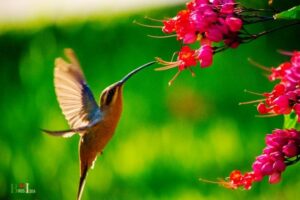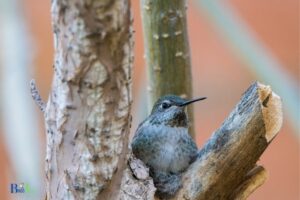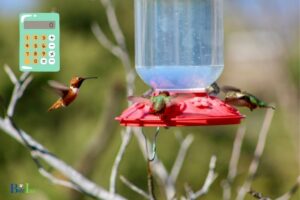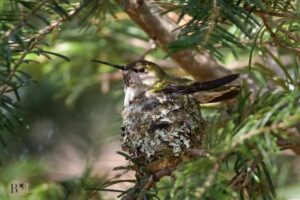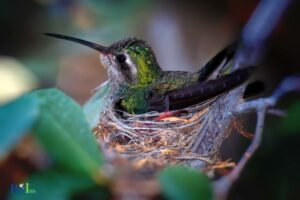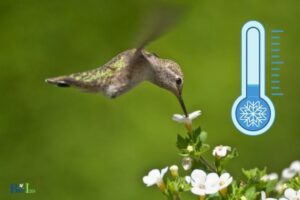Why Does a Hummingbird Keeps Visiting You? 6 Reasons!
A hummingbird keeps visiting you because it associates your presence with a reliable source of food, either through nectar-rich flowers or a feeder you provide.
Hummingbirds, known for their incredible flying skills and vibrant colors, are highly territorial and have excellent memories.
They remember the locations of various food sources and revisit them repeatedly to maintain their high energy levels.
When a hummingbird finds a reliable food source, it will keep coming back to it, even if it is near you.
In summary, a hummingbird keeps visiting you because it has identified your presence as a consistent and reliable source of food.
To further encourage these delightful visitors, plant nectar-rich flowers or set up a hummingbird feeder in your garden.
Make sure to keep the feeding area clean and filled with fresh nectar, and you’ll continue to enjoy regular visits from these fascinating birds.
6 Common Reason For Why Hummingbirds Keep Visiting You
| Reason | Explanation |
|---|---|
| Feeding | Hummingbirds are attracted to nectar-rich flowers and sugar water feeders, which provide them with energy. |
| Territory | Hummingbirds are territorial and may visit to establish a feeding territory around your garden. |
| Nesting | If a hummingbird finds a suitable nesting site near you, it may return frequently to nest and raise its young. |
| Safety | Your location may provide a safe and sheltered area for the hummingbird to rest and avoid predators. |
| Familiarity | Hummingbirds have a good memory and will repeatedly visit reliable food sources, such as your garden. |
| Colors | Bright colors, especially reds and oranges, attract hummingbirds and may be the reason they visit you. |
Key Takeaway

Five Facts About Why Hummingbirds Keep Visiting You
Understanding The Fascinating Nature Of Hummingbirds
Hummingbirds are fascinating creatures that never fail to capture our attention. It is not uncommon for people to notice a hummingbird visiting their garden or hovering near them while they spend time outdoors.
In this section, we will explore the basic facts, unique characteristics, and special qualities of hummingbirds.
Basic Facts About Hummingbirds
- Hummingbirds are tiny birds with iridescent feathers that create a humming sound when they fly.
- They are only found in the americas, from alaska to tierra del fuego.
- Hummingbirds are incredibly fast birds, capable of flying in every direction and reaching speeds of up to 60 miles per hour.
- Their wings beat an average of 50 times per second, and their heart rate can reach up to 1,260 beats per minute.
- They are the only birds that can fly both forwards and backwards.
Why Hummingbirds Are Special
Hummingbirds are unique creatures with many special qualities that set them apart from other birds.
Here are some of the reasons why hummingbirds are so special:
- Hummingbirds are the smallest birds in the world, with the bee hummingbird from cuba measuring only two and a quarter inches long and weighing only 0.06 ounces.
- They have a very high metabolism, which allows them to eat up to twice their body weight in nectar every day.
- Hummingbirds can see ultraviolet light, which helps them locate flowers and identify ripe fruit.
- They are able to slow down their metabolism at night to conserve energy, which allows them to survive cold temperatures and periods of food scarcity.
- Hummingbirds are important pollinators, and some plant species depend on them for cross-pollination.
The Unique Characteristics Of Hummingbirds
The unique characteristics of hummingbirds make them fascinating creatures to observe and study.
Here are some of the unique features of hummingbirds:
- Hummingbirds have a long, thin beak that allows them to access the nectar deep within flowers.
- They have a specialized tongue that can extend out of their beak and into flowers to extract nectar.
- Hummingbirds have excellent eyesight and can see a wide range of colors, including ultraviolet light.
- They are incredibly agile birds that can fly in every direction and hover in mid-air.
- Hummingbirds have an incredibly fast metabolism, which allows them to digest their food quickly and efficiently.
Hummingbirds are truly fascinating creatures with many unique qualities and special characteristics.
Whether you are a bird watcher or just someone who enjoys spending time in nature, observing hummingbirds is an experience that will leave you in awe of their incredible abilities and beauty.
Their Unmatched Metabolism
If you have noticed a hummingbird repeatedly visiting your garden or balcony, you might wonder why they are so attracted to you.
Besides their striking appearance and ability to hover mid-air, hummingbirds possess an unmatched metabolism that enables them to fly at high speeds and undertake long migrations.
In this blog post section, we will explore the reasons why hummingbirds might be visiting you, focusing on their noteworthy metabolism.
Significance Of Hummingbirds In The Ecosystem
Hummingbirds play a crucial role in the ecosystem as one of the primary pollinators of various plants, including wildflowers, fruit trees, and garden plants.
As they fly from one flower to another in search of nectar, they transfer pollen from one plant to another, facilitating the fertilization process and helping to maintain the diversity of plant species.
In turn, this supports other animals that depend on plants as a source of food and shelter. Hummingbirds have an outstanding metabolism that is unlike any other bird species.
Their bodies are designed to support the high-energy demands fueled by their constant wings flapping.
The following are some of the remarkable features that contribute to their unmatched metabolism:
- High heart rate: Hummingbirds have a heart rate that is up to 20 times faster than humans, beating up to 1,200 times per minute. This high heart rate supplies sufficient oxygenated blood to their muscles during flight.
- Rapid breathing: They breathe at an exceptional rate, inhaling and exhaling up to 250 times per minute. This level of oxygen intake ensures that their muscles receive sufficient oxygen needed to maintain their high activity levels.
- Unique digestive system: A hummingbird’s digestive system can process nectar quickly, taking only 10 to 15 minutes to pass through their system. This ability to digest rapidly allows them to feed frequently, consuming up to twice their body weight in nectar every day.
- High-energy diet: Unlike most birds that rely on seeds or insects as their primary food, hummingbirds have a high-energy diet, mainly comprising of nectar and insects. This diet supports their high activity levels, enabling them to fly for extended periods without fatigue.
Is It Possible To Keep A Hummingbird As A Pet?
Despite their small size, hummingbirds are wild animals that require a specific habitat and elements for survival. It is not advisable to keep them as pets as they thrive in the wild and suffer in captivity.
Additionally, it is illegal to keep hummingbirds as pets in most places. Enjoy watching them from afar and create a hummingbird-friendly garden to encourage frequent visits.
The superb metabolism of hummingbirds enables them to engage in high-energy activities such as flying and feeding.
Their role in the ecosystem as pollinators of plants underscores their importance, making their presence a welcome sight in any garden or balcony. Remember to avoid keeping them as pets and appreciate their beauty from a distance.
Why Does A Hummingbird Visit Your Garden?
Hummingbirds are majestic creatures that seem to capture our attention whenever they visit our garden. But what makes them want to come back? In this post, we will explore the reasons behind a hummingbird’s visits to your garden.
Seasonal Migration Of Hummingbirds
Hummingbirds are migratory birds that follow a seasonal pattern. They are known to travel long distances from their breeding grounds to their wintering grounds.
The reasons why hummingbirds migrate can vary from food shortages to changes in daylight hours.
The key points are:
- Hummingbirds follow a seasonal pattern.
- They travel long distances from their breeding grounds to their wintering grounds.
Climate And Habitat Preferences Of Hummingbirds
Another reason why hummingbirds visit your garden is the climate and habitat preferences of these birds.
Hummingbirds prefer warm and humid environments, making your garden an ideal destination. They are also attracted to bright colors and sweet-scented flowers that signal nectar.
- Hummingbirds prefer warm and humid environments.
- They are attracted to bright colors and sweet-scented flowers.
How Habitat Destruction Affects Hummingbirds
Habitat destruction is a significant threat to hummingbirds. The destruction of their natural habitat means fewer places for them to feed and breed.
Hummingbirds also rely on insects for protein and their absence can dangerously affect them.
The key points are:
- Habitat destruction threatens hummingbirds’ survival.
- Destruction of their natural habitat results in fewer places for them to feed and breed.
Hummingbirds come to your garden for several reasons, including climate and habitat preferences, seasonal migration, and the presence of nectar-rich flowers.
As a result, ensuring a hummingbird-friendly garden can attract these beautiful creatures and contribute to their survival.
Factors That Attract Hummingbirds To Your Garden
Hummingbirds are fascinating creatures that can bring joy and color to your garden. If you have noticed a hummingbird visiting your garden frequently, it means you are doing something right.
There are certain factors that attract hummingbirds to your garden, and we will explore them in this section.
Types Of Flowers That Attract Hummingbirds
Hummingbirds are known for their love of flowers. They use their long beaks to extract nectar from flowers and in the process, pollinate them.
If you want to attract hummingbirds to your garden, these are the types of flower to plant:
- Coral bells
- Bee balm
- Fuchsia
- Salvia
- Columbine
- Penstemon
- Cardinal flower
- Trumpet vine
These flowers have tubular shapes that are perfect for the long beaks of hummingbirds. Hummingbirds are also attracted to bright and bold colors, including red, orange, and pink.
When choosing flowers for your garden, ensure you select a variety of shapes and colors to attract different species of hummingbirds.
Other Factors That Attract Hummingbirds
Aside from flowers, there are other factors that attract hummingbirds to your garden.
Some of these include:
- Water: Hummingbirds need water to survive, and having a water source in your garden can attract them. You can set up a shallow bird bath with a fountain or a mister to attract hummingbirds.
- Feeder: A hummingbird feeder is another way to attract hummingbirds. Fill the feeder with a nectar solution made with four parts water and one part white granulated sugar.
- Insects: Hummingbirds also feed on insects, so having an insect-friendly garden will attract them. Planting herbs such as basil and oregano can attract insects and in turn, attract hummingbirds.
Attracting hummingbirds to your garden requires a combination of factors such as the types of flowers you plant, availability of water, and the presence of insects.
By following these tips, you should be able to attract these tiny creatures to your garden and enjoy their beauty and charm.
Top 5 Flowers To Plant In Your Garden
Building A Hummingbird Feeder And Nectar Recipe
Do you want to attract hummingbirds to your garden? The best way to do so is by setting up a hummingbird feeder and providing them with a nectar recipe that they can’t resist.
Here’s how:
- Select the right feeder: Hummingbird feeders come in various shapes and styles. Choose one with a bright color that can catch their attention, and make sure the feeder has perches that are comfortable for them to rest on.
- Create a safe location: Hummingbirds are tiny creatures, and they need to feel safe when they come to feed. Place your feeder in a spot where they can see approaching predators and escape without any issues.
- Make the nectar: Mix four parts water with one part granulated sugar to make the perfect nectar for hummingbirds. Avoid the use of honey or artificial sweeteners as they can be harmful to these little birds.
- Clean and refill regularly: Hummingbirds are picky eaters, and they won’t feed from a dirty feeder. Clean and refill your feeder every two to three days to prevent the growth of mold or bacteria in the nectar.
- Avoid using chemicals: Pesticides, herbicides, and other chemicals can be hazardous to hummingbirds and can have adverse effects on their health. Keep your garden as natural and chemical-free as possible.
Hummingbirds love colorful and fragrant flowers. Planting the right flowers in your garden will attract more of these beautiful creatures.
Here is a list of the top 5 flowers to plant to attract hummingbirds:
- Bee balm: Also known as monarda, bee balm is a vibrant and fragrant flower that hummingbirds can’t resist. The flowers come in various colors, including pink, purple, and white.
- Salvia: Salvia is a popular choice for hummingbirds as it produces nectar-rich tubular flowers that are easy to feed from. Salvia flowers come in different hues of blue, purple, and red.
- Trumpet vine: Trumpet vines produce large and showy orange-red flowers that hummingbirds adore. This plant grows rapidly, and it’s important to give it plenty of space to avoid overgrowth.
- Red hot poker: Kniphofia, also known as red hot poker flowers, bloom in shades of orange, red, and yellow. These bright colors are perfect for attracting hummingbirds to your garden.
- Lupine: Lupines produce tall spikes of pea-like flowers in various shades of blue, pink, and purple. These flowers are a great food source for hummingbirds, and they look lovely as cut flowers in a vase.
By following these tips and planting the right flowers, you’ll have hummingbirds flocking to your garden in no time.
Remember to maintain your feeder and keep your garden chemical-free to ensure the safety and health of these delightful birds.
How To Keep Hummingbirds Coming Back To Your Garden
Have you ever wondered why a hummingbird keeps coming back to your garden? Hummingbirds are fascinating creatures that are often attracted to gardens with bright, colorful flowers.
They feed on nectar to provide the energy they need for their rapid wing movements, and they also enjoy feasting on insects.
In this post, we’ll explore how you can keep hummingbirds coming back to your garden with the following tips:
Creating A Safe And Conducive Environment For Hummingbirds
Hummingbirds are very selective about the environment they feed and nest in. They have evolved to be very agile, but they are still susceptible to predators.
To create a safe and welcoming environment for hummingbirds, you can:
- Keep your garden free of pesticides and chemicals that may harm or discourage hummingbirds.
- Use a hummingbird feeder to supplement the nectar available in your garden. A hummingbird feeder is a simple device that attracts hummingbirds by mimicking the nectar found in flowers.
- Plant a variety of flowers that bloom throughout the year, as hummingbirds need a constant source of nectar. Red, orange, and pink flowers are most attractive to hummingbirds.
- Provide a source of water for the hummingbirds to drink and bathe in. A shallow bird bath or fountain with a bubbler is ideal, as it helps to keep the water fresh and aerated.
Feeding Tips For Hummingbirds
Hummingbirds have very high metabolisms, and they need to consume up to 50% of their body weight in nectar and insects each day.
To keep hummingbirds coming back to your garden, you should ensure they always have enough food by:
- Refreshing the nectar in your hummingbird feeder every few days, as old nectar can go bad and grow fungus or bacteria.
- Preparing homemade nectar by mixing one part sugar to four parts water. Avoid using honey, as it can contain harmful bacteria.
- Placing the hummingbird feeder in a shaded area to prevent the nectar from fermenting in the heat of the sun.
By implementing these tips, you can create a safe and inviting environment for hummingbirds to feed and nest in.
Remember to always be patient, as it may take some time for hummingbirds to discover your garden.
With a little effort and patience, you’ll be able to enjoy watching these magnificent creatures in your backyard.
What To Do If A Hummingbird Is Injured?
Have you been seeing more hummingbirds around your garden lately? It’s not surprising – these little birds are fascinating and beautiful creatures that many people enjoy attracting to their yards.
However, what can you do if you come across an injured hummingbird? This article will explore that question and offer some tips for attracting and keeping hummingbirds in your garden.
Best Practices For Attracting And Keeping Hummingbirds In Your Garden
If you want to attract hummingbirds to your garden, there are a few best practices you should follow.
Here are some tips to get you started:
- Plant native flowers that are rich in nectar: Consider planting flowers such as salvia, columbine, bee balm, and trumpet vine. These flowers are particularly attractive to hummingbirds.
- Provide plenty of perching spots: Hummingbirds need places to rest, too! Provide some perching spots, such as small branches or wire hangers, for them to sit and rest while they visit your garden.
- Offer a sugar water solution in a hummingbird feeder: If you want to supplement the nectar available in your garden, you can offer a mixture of sugar and water in a hummingbird feeder. A good ratio to follow is four parts water to one part sugar.
- Keep your garden free of pesticides: Hummingbirds are highly susceptible to pesticides, so it’s important to keep your garden free of any harmful chemicals. Opt for natural pest control methods instead.
What To Do If A Hummingbird Is Injured
If you come across an injured hummingbird, your main priority is to get it the help it needs.
Here are some steps you can take:
- Prepare a small box with air holes: You’ll need a small box to transport the hummingbird safely. Make sure it has small air holes to provide ventilation.
- Use a towel to carefully pick up the hummingbird: Gently wrap the hummingbird in a towel or cloth. Be very careful not to injure it further.
- Contact a wildlife rehabilitation center: Look up your local wildlife rehabilitation center and contact them immediately. They will be able to provide specific instructions for how to transport the injured hummingbird safely.
- Keep the hummingbird warm and quiet: While you wait for help to arrive, keep the hummingbird in a warm, quiet place. Do not offer it any food or water.
Remember, it’s important to respect wildlife and their natural habitats. By following these tips, you can attract hummingbirds to your garden and help protect these beautiful creatures.
FAQ On Hummingbird
Why Does A Hummingbird Keep Visiting You?
How Often Should I Fill My Hummingbird Feeder?
Can I Make My Own Hummingbird Nectar?
What Plants Attract Hummingbirds?
How Can I Get A Hummingbird To Land On My Hand?
Conclusion
As we’ve explored, hummingbirds are fascinating creatures, and having them visit you in your backyard is truly a special experience. As a homeowner, there are several steps you can take to make your yard more inviting to these beautiful birds.
By providing a variety of brightly colored flowers, implementing hanging feeders, and maintaining a clean and safe environment, you can create an ambiance that attracts hummingbirds and keeps them coming back for more.
Additionally, it’s important to consider the significance of these tiny creatures in our ecosystem and their role in pollination. By taking the time to learn about and appreciate hummingbirds, we can all contribute to the preservation of their species and the health of our planet overall.
So sit back, relax, and enjoy the show – your hummingbird visitors are sure to delight and enchant you for years to come.

